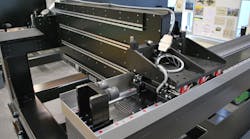Integrating Medical Devices: Success Starts at Design
READ MORE: Linear Motion a Lifeline in Medicine
To provide their customers with the highest reliability product, manufacturers must think big, long-term and preventively. In many situations, risk can be eliminated before a moving part arrives at the loading dock.
Do not think in terms of buying even the best single component. Instead, focus on creating a complete metrology solution from the floor up to the point of measurement. Besides highest-performance cross roller bearings to provide extreme smoothness and speed, seek a solution that takes ownership of the entire assembly. This includes not just the stage but the properly isolated frame to which it is mounted. This also includes state-of-the-art active dampening measures. This kind of integrated technology helps ensure solid control of both component movement and any ancillary vibration.
In terms of manufacturing, perhaps the process that holds the most potential for causing mishaps down the line is designing and constructing the control element or elements that will direct the linear motion system. Issues such as improper wiring can crop up and need to be guarded against, as they must in other parts of the build. But it is the myriad steps of programming the control and integrating the hardware and software that demand the most care.
Among the questions to ask:
- Are all limit switches—with sensors that protectively trigger on or off states when the stage hits a point, such as a hard stop for limit of travel—ordered as an option if a stage is a stock purchase?
- Were all properly set, correctly oriented (with plus or negative limits sent to left or right pins, as applicable), suitably connected to the controller and appropriately used?
- Are limits for the electrical current set to the proper levels? Is the stage correctly tuned?
- Is the velocity limited so that it never exceeds the specified limits of any component in the system?
At the extreme, a mistake here might even lead to a runaway stage in the application. The moving part loses communication with the controller and starts moving on its own volition, perhaps to the point where it goes beyond the desired end of travel and impacts another part of the machine.
Troubleshooting Issues
In a more likely scenario, a control design oversight could lead to an overcurrent situation and cause motor burnout. For example, suppose the limits are not correctly specified, and during travel, a motor-driven component (such as a stage or table) is physically impeded by an unexpected object on the rail (a fallen screw, an operator’s hand, its end of travel, etc.). In this case, the motor may draw more and more amperage until it burns out. The result is equipment shutdown, disassembly, and service or replacement. All of these outcomes include significant downtime and costs for that part of the application.
An even subtler problem may arise if the control designers neglect to consider every possible condition that could occur during linear motion equipment operation. For instance, a three-axis linear motion component might perform perfectly during routine operations through thousands of iterations. But in what might be an exceptionally uncommon configuration with no limit switches set (such as when the X, Y and Z axes all happen to be at their very lowest points of travel simultaneously), the moving component may run into a structure in its surrounding environment. When not accounted for in planning, this could include hitting a nearby post or holder or dispenser.
Linear bearings are excellent at accommodating continuous dynamic and static loading, but not impact loading. If a linear motion component hits something at high velocity, it generates what could well be an out-of-spec impact load. Potentially a single such hit could destroy every bearing in the system.
Mario DeVincentis is engineering manager at Schneeberger Inc. He is well-known in the area of linear technology, with 30 years of experience in system development, system manufacturing and applications engineering works to identify opportunities and optimize processes.

